Archived Mold Remediation Blog Posts
Surprising places mold can be found
5/3/2019 (Permalink)
 Mold may be growing on your mattress
Mold may be growing on your mattress
It’s a well-known fact that mold grows in damp spots, typically in the kitchen, basement or bathroom. But below are some additional spots that may leave you cringing.
In your mattress.
Why it grows there – Mold grows in damp places, and though you might not like to think about it, your mattress can get damp. It can carry moisture from things like perspiration and spills, making it an ideal home for mold.
How to clean it – You can start by vacuuming both sides of the mattress, and then of course, cleaning out that vacuum to avoid the spread of mold spores. Then, mix together an equal ratio of rubbing alcohol and water, dip a cloth in the mixture, and scrub the mattress. After that, spray a disinfectant on the mattress, and sit it out to dry in the sunshine (a very important steps because, of course, getting rid of moisture is crucial). However, if you see the mold spread to the floors and walls of your bedroom as well, it’s best to call the experts!
On your dishes.
Your dishes, those things you serve the food you and your family eat on. While it may make you gag, it does make sense.
Why it grows there – When the dishes aren’t completely dry, but you start stacking them anyway, you set up a prime spot for mold to grow.
How to clean your dishes – To start, make sure your dishes are totally moisture-free before stacking and putting them away. If it’s too late for that step, simply run the dishes through a dishwasher (washing and sanitizing them), and wipe down your cupboards using a vinegar and water solution and a cloth. Again, if the mold has spread to your sink, counter or throughout your cabinet, it’s best to call the experts, SERVPRO of Cambridge/Belmont
On your toothbrush.
This could be the most important takeaway of them all mostly because you are potentially putting mold particles directly into your mouth.
Why it grows there – When toothbrushes don’t receive a proper chance to dry out between brushing, mold has the perfect opportunity to thrive.
How to clean it – Okay, forget cleaning mold off your toothbrush. Just go buy a new, definitely-mold-free one. And then use these tips to keep it that way.
- First, buy a new one frequently. Even if it doesn’t look frayed, you should be replacing it at least every three months.
- Second, use toothpaste with germ-fighting triclosan/copolymer.
- Third, don’t share toothbrushes.
- Fourth, close the lid to your toilet while flushing! You wouldn’t believe how far those germs can fly.
- Lastly, don’t store your toothbrush in an airtight container. To avoid mold growth, it needs to be exposed to the open air.
No matter where you find mold growing in your home, you’ll need to clean it up and fix the moisture problem immediately. Otherwise, the mold will continue to grow and potentially damage any surface it calls home. If you have a mold issue, please call SERVPRO of Cambridge/Belmont (617) 864-7378 to assist you.
Mold in the basement
5/2/2019 (Permalink)
 Mold growing on sheetrock in the basement
Mold growing on sheetrock in the basement
The Millers were away for a week and when they came home they noticed a smell coming from the basement. A pipe had developed a leak and was dripping water onto the carpet in their finished basement. The Millers called SERVPRO of Cambridge/Belmont to assist them with the water damage. The crew arrived and checked the basement walls and floor for excessive moisture content. The SERVPRO crew determined that the water wicked up the walls causing the positive readings. SERVPRO of Cambridge/Belmont’s technician recommended the removal of 2 feet of walls and removal of the insulation behind the walls so that the basement could be dried properly. The customer did not follow the technician’s advice and wanted only to have the pad removed and the carpet dried. A few weeks later, the Millers discovered black spots growing on the walls. They called SERVPRO of Cambridge/Belmont again to assess the situation. the crew chief determined that mold had started growing and recommended that the walls be cur 6”inches past the mold growth, remove the insulation, hepa-vacuum and spray an anti-microbial behind those walls. If you have water damage call SERVPRO of Cambridge/Belmont (617) 864-7378 to assist you and please follow the recommendations of the crew.
The Importance of Clean Air to Prevent Mold
8/8/2018 (Permalink)
 Plants can help prevent mold from breeding in your home.
Plants can help prevent mold from breeding in your home.
One of the largest factors in mold survival 101 is the amount of moisture that is located within the air. Mold will grow anywhere on any substance that dampness is present. Most people do not realize as well as causing mold, excess moisture can also contaminate the air as well. Mold that is located within your home is a source of pollution all in itself. Mold particles can release toxic particles that will emanate and ilfitrait the air that you are breathing in. Also, not to mention the fact that damp itself can cause water vapor, which eventually will turn into microbial growth leading to more mold and now we are caught in a cycle. Making sure the moisture between cleanliness of the air and the actual tangle things are being controlled.
But there are many other things you can do to reduce the growth of mold and keep the air around you clean. Here are some tips from SERVPRO of Cambridge/Belmont (617-864- 7378).
Ventilation
Quick, easy and most importantly… free! Making sure that you keep your windows open whenever it is possible will ensure a healthy dose of air circulation.
Extractor Fans
Gas stoves and cooking pollutants in the kitchen as well as aerosol sprays and fragranced products in the bathroom are responsible for these rooms being high-toxin areas, so use extractor fans to ensure the air is regularly cleared. If you do not have a fan ventilating in a bathroom where showers are located, SERVPRO of Cambridge/Belmont (617-864- 7378) would recommend installing one. Bathrooms are a breeding ground for mold, especially one without a vent.
Clean
Making sure all surfaces are regularly cleaned and dusted especially bathroom and kitchens are a must. Vacuuming and dusting are major when trying to prevent mold and particles from getting into your air.
Dehumidifiers
These are a must! Every indoor space should have one of these as it is the perfect weapon against excess moisture, which could lead to black ceilings, paint, and wallpaper peeling off. Not to mention the fact that it will help protect your personal belongings and keep your food fresher for longer.
Plants
Plants one might ask? Other than just looking pretty, indoor plants, especially leafy greens, are key in helping to eliminate airborne pollutants. Thus in turn, purifying the air. So next time your out and about maybe think of purchasing a few leafy green plants to put throughout your home!
8 Places Most People Do not Know Mold Exists
8/3/2018 (Permalink)
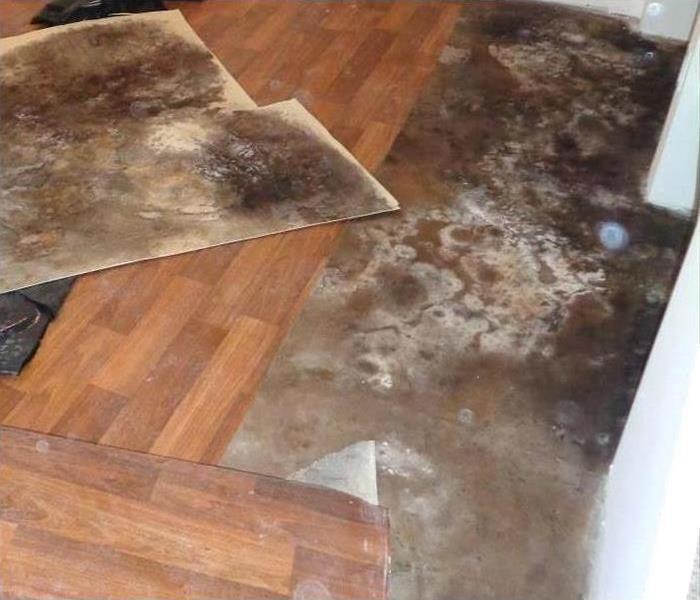 Invasive mold found under hardwood floors
Invasive mold found under hardwood floors
Mold is defined as a fungus that can spread rapidly and can take over you home and work space rather quickly. The most common places for mold to hide is, Carpeting, Furniture, Closets, Clothes, HVAC Systems, Drywall, Ceiling, and Flooring.
Carpeting
No matter how small the amount of carpet is that has liquid dropped on it, it is always a good idea to take precautions and check to see if mold has started to grow in or underneath the surface. Some of the smallest spills could lead to the biggest problems over time if not taken care of properly.
Furniture
Most people do not realize that when water or liquid is spilled on a piece of furniture it could potentially be a breeding ground for mold. Liquid can seep into the fabric and if not dried correctly could start to spread through the piece of furniture
Closets
Closets would be the last place that one would think mold would grow in. Mold spores are found in the air and can land on anything and everything throughout your home. Mold spores tend to grow more rapidly in dark, damp, or humid environments. That is why your closet can be a good breeding ground for mold spores.
Clothes
One might ask mold can grow in clothes?! Not to panic if taken care of properly this can be avoided. Most people organize their closets in conjunction with what season is approaching. Last season's clothes go into the back of the closet to sit there until it comes around again. Which mean out of sight out of mind. This is when mold spores can start to grow. Some clothes after sitting for so long can come out and smell musty. A suggestion for SERVPRO of Cambridge/Belmont 616-864-7378 is to wash your clothes each season before wear. If mold does become a problem in your closets feel free to contact us so we are able to get your closet back to “Like it never even happened”!
HVAC Systems
What is your HVAC system? You probably think of it as the thing that keeps your home warm or cool depending on the season. What it really is, is a series of long fully enclosed duct work that traverse every part of your home. These are the places that never see light and can collect several different types of bacteria, including mold spores. This is something that can be easily prevented. Getting duck worked cleaned each year can help prevent from a catastrophic mold over take throughout your home.
Drywall
Drywall loves to absorb anything and everything that comes into contact with it. Some examples are odors, bacteria, smoke, or moisture. Whenever something is absorb it can be naked to the eyes. You will not be able to notice any damage that has taken place unless it starts to smell or starts to peep through onto the drywall.
Ceiling
Most people will not notice anything wrong with the ceiling until it is visible. Which means, at that time mold has had a chance to grow throughout it. This usually happens when there is a overflow of a toilet or bathtub. Do not fret! SERVPRO of Cambridge/Belmont 616-864-7378 has the tools to help fix your mold problem. Give us a call we are available 24/7 365 days a year.
Flooring
One detail that you cannot forget about is when flooring gets wet the moisture might have disappeared on the top but that does not mean that the liquid is not deep under the surface waiting to start breeding. More often than not moisture can get underneath and become a breeding ground for mold. Some examples of where mold can grow in a moist or humid area is your attic, storage room, crawl space, or inside your washer and dryer. Some tips to make sure that your floor is staying clean and dry is to make sure that spills, when they happen, are taken care of and not just left to seep into the floor to cause damage.
6 Signs You Might Have Carpet Mold
8/1/2018 (Permalink)
Mold is extremely invasive and can become deadly over time for people to be both living or working in an environment that contains mold. Make sure when liquids are spilled, no matter how small, you clean up properly and check over time to see if mold has grown within the area.
Do you have musty odors that are smelling throughout your home or business?
Have higher Incidence of Allergies that have occurred over time?
Does your space have a damp carpet?
Have you looked under your carpet for mold?
Do you see white, green, or black spots that have appeared that were not there before?
Have you tested your carpet for mold with a mold test?
These are six MAIN signs that you have mold growing under your carpet. Call SERVPRO of Cambridge/Belmont 617-864-7378 to keep your spaces safe and healthy.
Hidden leaks can lead to mold
7/19/2018 (Permalink)
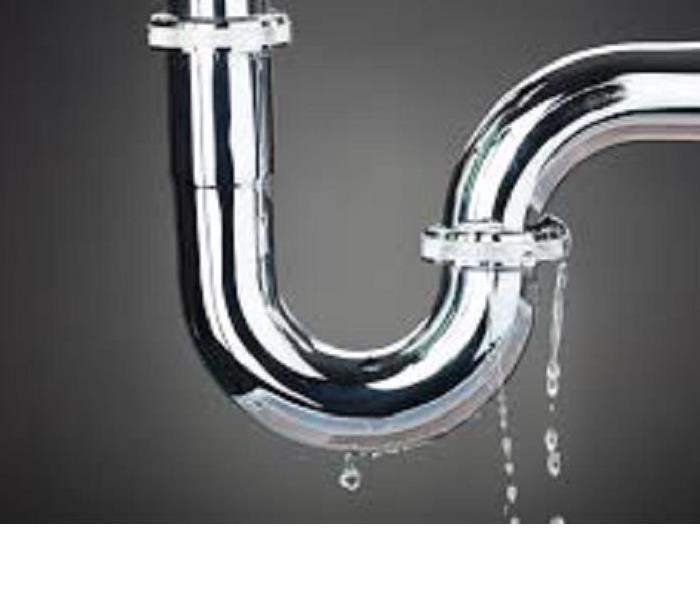 If you see a leaky pipe, call a plumber before mold can develop
If you see a leaky pipe, call a plumber before mold can develop
A homeowner in Belmont, MA moved a cabinet in their living room and saw black spots behind the cabinet and also growing on the cabinet. The homeowner called SERVPRO of Cambridge/Belmont to assess the situation. The SERVPRO technicians using a moisture meter discovered the wall and ceiling were both wet. The technicians went upstairs to the room above the living room to determine the source of the water. The room above was a bathroom, the technicians using the moisture meter, discovered the bathroom vanity was wet. SERVPRO of Cambridge/Belmont’s technicians removed the wall and found an old leaky pipe that had probably been dripping for a long period of time causing the mold growth in the living room.
Mildew and molds are fungi - simple microscopic organisms that thrive anywhere there is a moist environment. Molds are a necessary part of the environment; without them, leaves would not decay and aspects of soil enrichment could not take place. It is their ability to destroy organic materials, however, that makes mold a problem for people - in our homes and in our bodies.
If you think you have a mold issue, call SERVPRO of Cambridge/Belmont (617) 864-74378 to assist you
Mold Facts
7/12/2018 (Permalink)
 Mold on backside of shhetrock
Mold on backside of shhetrock
Microscopic mold spores naturally occur almost everywhere, both outdoors and indoors. This makes it impossible to remove mold from a home or business. Therefore, mold remediation reduces the mold spore count back to its natural or baseline level. Some restoration businesses advertise “mold removal” and even guarantee to completely eradicate mold forever, which is a fallacy. Consider the following mold facts:
- Mold is present almost everywhere, indoors and outdoors.
- Mold spores are microscopic and float along in the air and may enter your home through windows, doors, or AC/heating systems or even hitch a ride indoors on your clothing or a pet.
- Mold spores thrive on moisture. Mold spores can quickly grow into colonies when exposed to water. These colonies may produce allergens and irritants.
- Before mold remediation can begin, any sources of water or moisture must be addressed. Otherwise, the mold may return.
- Mold often produces a strong, musty odor and can lead you to possible mold problem areas.
- Even higher-than-normal indoor humidity can support mold growth. Keep indoor humidity below 45 percent.
If you think you have mold, please call SERVPRO of Cambridge/Belmont (617) 864-7378 to assess your situation.
Common causes of mold
7/5/2018 (Permalink)
 Active mold growth in the basement
Active mold growth in the basement
One of the rooms in the house where you'll most often see mold is the basement.
This Blog informs you about the most common causes and the signs of mold in the basement. It also lets you know how to find mold growth in the basement and to prevent mold from growing in the basement.
Causes of Mold in Basement
There are many sources of moisture found in the basement. And any water problem in the basement usually takes a long time to dry out. This is because the basement gets no sunlight, very little ventilation and is often humid.
To make matters worse, once mold has begun to grow in the basement it will probably go unnoticed for a long time since people don't spend much time in their basements. People rarely clean their basements too and the dust and dirt helps mold to grow.
Mold loves to grow on some of the building materials in the basement. Some favorites are drywall, wood and insulation.
Mold and Flooding
Mold from Basement Leaks
Leaking pipes in the basement or in nearby rooms lead to basement mold growth. Water in the ground can also find its way into the basement through cracks in the walls.
Basement Humidity and Mold
Once water in the basement evaporates it raises the humidity level in the basement. The humidity then usually stays high thanks to poor ventilation and no sunlight. Some molds can begin to grow in the basement just from this high level of humidity.
Signs of Mold in Basement
One of the clearest signs that you have mold in your basement is the smell. Because of the stagnant air in the basement, odors build up and become very noticeable. Don't ignore a musty or moldy smell in the basement as it probably means you have a basement mold problem.
If you need help with mold, please contact SERVPRO of Cambridge/Belmont (617) 864-7378
Mold in the Basement
7/2/2018 (Permalink)
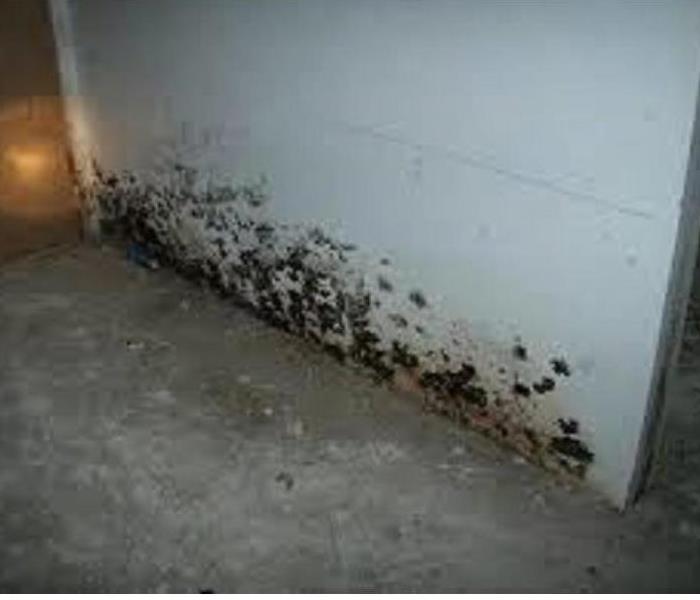 Mold growing on the walls
Mold growing on the walls
The Millers were away for a week and when they came home they noticed a smell coming from the basement. A pipe had developed a leak and was dripping water onto the carpet in their finished basement. The Millers called SERVPRO of Cambridge/Belmont to assist them with the water damage. The crew arrived and checked the basement walls and floor for excessive moisture content. The SERVPRO crew determined that the water wicked up the walls causing the positive readings. SERVPRO of Cambridge’s technician recommended the removal of 2 feet of walls and removal of the insulation behind the walls so that the basement could be dried properly. The customer did not follow the technician’s advice and wanted only to have the pad removed and the carpet dried. A few weeks later, the Millers discovered black spots growing on the walls. They called SERVPRO of Cambridge/Belmont again to assess the situation. SERVPRO determined that mold had started growing and recommended that the walls be cur 6”inches past the mold growth, remove the insulation, heap-vacuum and spray an anti-microbial behind those walls. If you have water damage call SERVPRO of Cambridge/Belmont (617) 864-7378 to assist you and please follow the recommendations of the crew
Mold in the House
5/9/2018 (Permalink)
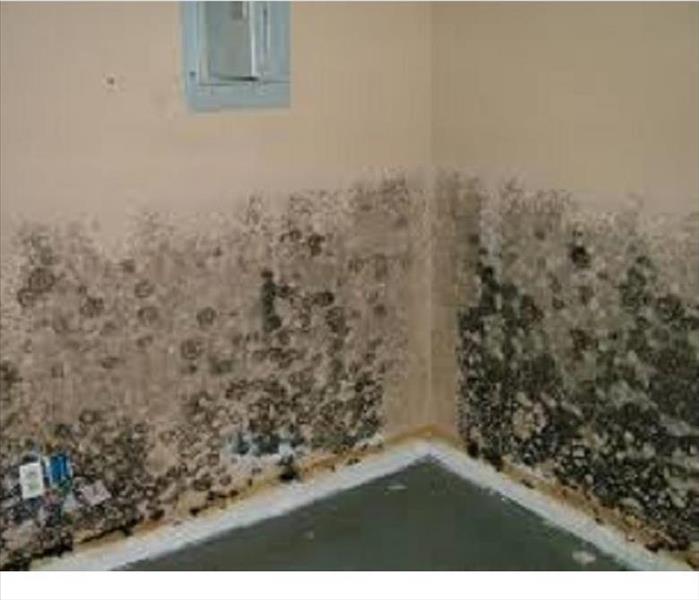 Mold in home left untreated
Mold in home left untreated
Mold issues in the home
Black mold belongs to the fungal family. Fungi make up 25% of our planet’s biomass, and they are very diverse, including mushrooms, toadstools, molds and mildews. What unites them all is a lack of chlorophyll.
Although many fungi are harmless, there are also some mold such as aspergillus may not be as harmless.
Black mold loves to grow on cellulose, which includes substances such as straw, grains, paper (including wallpaper) and wood. It thrives when that substrate has a relative humidity of 15% and the ambient environment is around 90% (hello, bathrooms). But basically it will take advantage of anywhere that water has got in, so a leaky roof, faulty damp-proof course or a cracked drain are all open invitations to black mold.
Black mold facts:
- It is a fungus called Stachybotrys chartarum.
- Black mold poisoning is called stachybotryotoxicosis (literally “poisoned by stachybotrys”).
- Black mold is in part responsible for “sick building syndrome,” where people develop respiratory difficulties, chest tightness and headaches.
If you think you have mold please call SERVPRO of Cambridge/Belmont (617) 864-7378 to assist you with the mold remediation.
Mold in the workplace
5/8/2018 (Permalink)
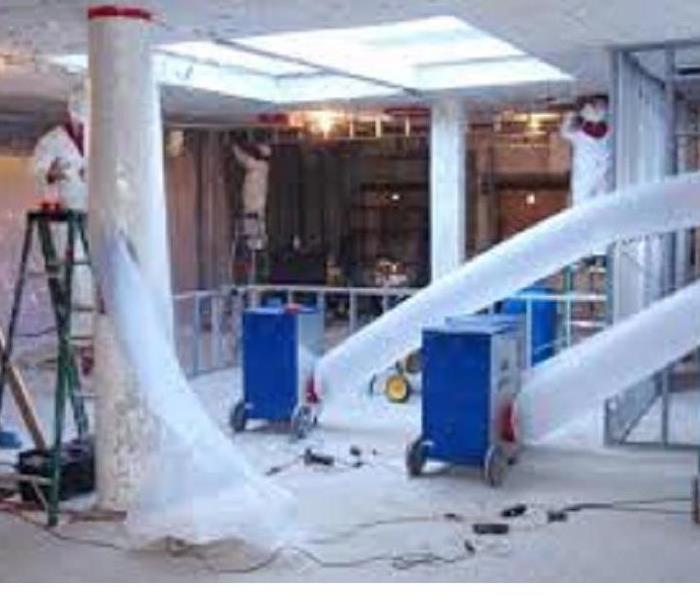 Mold Remediation at a local school
Mold Remediation at a local school
Toxic Mold: What Every Employer Should Know
Mold is a favored word among lawyers and a feared word among building owners, employers and landlords.
Lawsuits arising out of mold and claiming "sick building syndrome" are common. Multi-million dollar verdicts are not unheard of. Mold, in the words of some, is becoming "the next asbestos."
An $8 billion class-action lawsuit was brought by 300 tenants in a large apartment building in New York. The Environmental Protection Agency (EPA) was sued by employees claiming they became ill because of mold exposure while working at EPA headquarters. Even Hollywood is involved: Ed McMahon sued his insurer for $20 million, claiming that toxic mold in his Beverly Hills home killed his dog.
Mold has even reached the attention of the U.S. Congress. Last year, Representative John Conyers of Detroit introduced a proposed bill, the "United States Toxic Mold Safety and Protection Act of 2002," intended to set standards for indoor mold levels and to provide for related research.
Due to increased public awareness,
Almost mounting to hysteria, the number of legal claims is sure to mount. Workers who believe they are being exposed to mold may not want to work, their productivity may decline and they may file worker's compensation and disability claims. As an employer and/or a building owner, what can you do to try to limit your legal liability?
Look for Signs of Mold
With all of this attention, you may think that mold infestation is something new or uncommon. It is not. Mold is present in all buildings in some form and quantity. However, certain species of mold spores, in large enough concentrations, can be toxic. Although the health problems of mold exposure are in debate, there is literature tying some health effects to mold exposure. People with immune-compromised systems may experience permanent health effects.
Physical symptoms related to exposure to mold or sick building syndrome include eye, nose and throat irritation; respiratory complaints; skin irritation; nausea; dizziness and fatigue. Alert your human resources department and/or office manager to be aware of any such symptoms. If numerous employees complain, or if employees complain of moldy smells, put the building owner on notice and request an investigation. If you own the building, consider hiring an air quality investigator. Although these symptoms could result from other factors, it is important to address them.
Look For the Cause
Mold needs water or moisture and oxygen to grow. Water does not have to flow into the building for there to be enough moisture to promote the growth of mold. Although one-time leaks or burst water pipes may not be a problem if repaired, even a one-time leak, if not properly addressed, can cause unacceptable mold growth. There are a number of potential causes of moisture or water entry:
- Lack of building maintenance
- Poor building design or construction
- Using wet building materials
- Leaky pipes, windows, or doors
- Regular, or even one-time flooding
- Simple plumbing mistakes
- Excessive humidity and condensation
- Improper landscaping design or maintenance outside the building, causing water to flow toward the building
- Any other serious water related problem
- Address Moisture or Water Issues Promptly
If your building is experiencing water penetration, consistent moisture or leaks, demand that the landlord investigate the cause and promptly provide you with an action plan. If the landlord does not act, put it on notice that you intend to act and that you will hold it responsible for the costs.
Call SERVPRO of Cambridge/Belmont (617) 864-7378 to make an assessment and to remediate the mold.
Mold facts
8/7/2017 (Permalink)
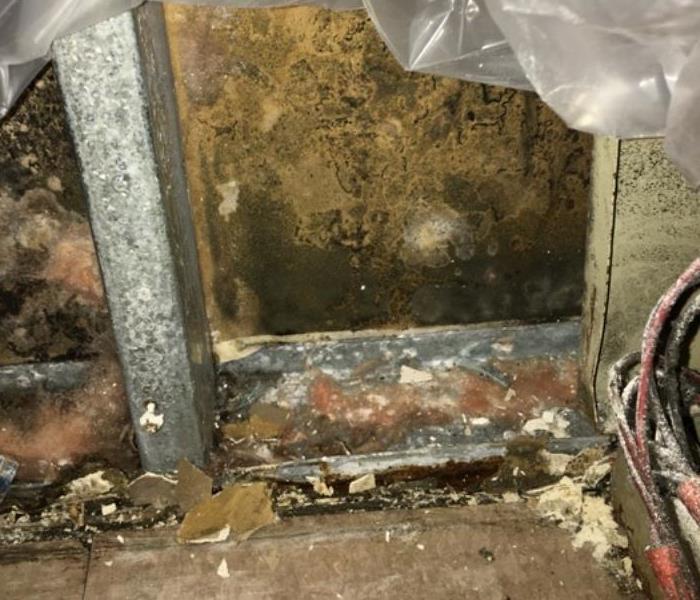 Heavy mold growth on back of shetrock
Heavy mold growth on back of shetrock
Mildew and molds are fungi - simple microscopic organisms that thrive anywhere there is a moist environment. Molds are a necessary part of the environment; without them, leaves would not decay and aspects of soil enrichment could not take place. It is their ability to destroy organic materials, however, that makes mold a problem for people - in our homes and in our bodies.
Mildew (mold in early stage) and molds grow on wood products, ceiling tiles, cardboard, wallpaper, carpets, drywall, fabric, plants, foods, insulation, decaying leaves and other organic materials.
Mold growths, or colonies, can start to grow on a damp surface within 24 to 48 hours. They reproduce by spores - tiny, lightweight “seeds”- that travel through the air. Molds digest organic material, eventually destroying the material they grow on, and then spread to destroy adjacent organic material. In addition to the damage molds can cause in your home, they can also cause mild to severe health problems. See the HEALTH section to check for possible mold related health problems.
Mold and mildew will develop within 24-48 hours of water exposure. Even worse, it will continue to grow until steps are taken to eliminate the source of moisture, and effectively deal with the mold problem.
Use the diagram on the facing page to assess the extent of mold in your home. We are all exposed to many kinds of mold both inside and outside the house. The exposure is greater in damp or wet conditions, especially when timely drying out do not have a chance to occur. Of the thousands of molds that exist, some are known allergens (aggravating or causing skin, eye, and respiratory problems), and a few molds produce harmful mycotoxins that can cause serious problems. But all molds, in the right conditions and high enough concentrations, are capable of adversely affecting human health.
Health issues caused by mold
The potential for health problems occurs when people inhale large quantities of the airborne mold spores. For some people, however, a relatively small number of mold spores can cause health problems. Infants, children, immune-compromised patients, pregnant women, individuals with existing respiratory conditions, and the elderly are at higher risks for adverse health effects from mold.
Typical symptoms reported from mold exposure include:
Respiratory problems -wheezing, asthma attacks, etc
Nasal and sinus congestion or dry, hacking cough
Eye irritation - burning, watery, redness
Nose or throat irritation -sneezing fits, bloody noses
Skin irritations -rashes or hives
Nervous system -headaches, memory loss, mood changes
Aches and pains
The more serious health problems have been associated with the toxic black mold, Stachybotrys atra. The mold is greenish-black and slimy, resembling tar or black paint. Stachybotrys typically grows only on repeatedly wetted materials that contain cellulose - from paper to ceiling tiles, and any kind of wood. In most cases, this mold can be removed by a thorough cleaning with a 10% bleach solution. Severe mold infestations may require the assistance of a professional with experience in dealing with Stachybotrys.
Mold prevention
There is no practical way for you to eliminate all of the molds and mold spores in the indoor environment. But there are many ways to help control moisture and mold growth in your home. Here is a partial list: Stop the water
- Fix leaks in pipes, and any damp areas around tubs and sinks, so that biological pollutants don’t have growing environments.
- Rebuild, or retrofit, with water-resistant building materials such as tiles, stone, deep-sealed concrete, galvanized or stainless steel hardware, indoor/ outdoor carpeting, waterproof wallboard, water-resistant glues, and so on.
- Prevent seepage of water from outdoors into your house. Rain water from gutters or the roof needs to drain away from the house. Ground around the house needs to slope away to keep basement and crawlspace dry.
- Cover dirt in crawlspaces with plastic to prevent moisture from coming from the ground. Ventilate the area as much as possible.
If you have a mold issue, please call SERVPRO of Cambridge/Belmont (617) 864-7378 to assist you.
Sick Building Syndrome
7/12/2017 (Permalink)
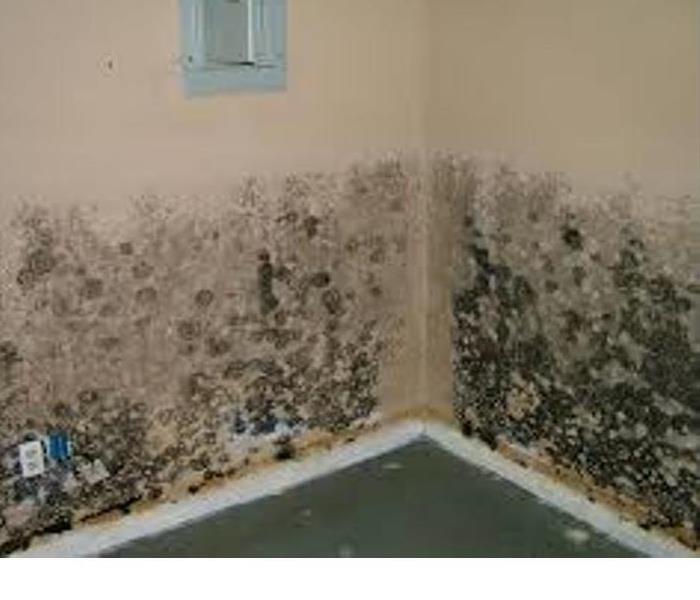 Mold growth inside a commercial building
Mold growth inside a commercial building
Toxins from mold can aerosolize directly into the air, which may help explain one cause of sick building syndrome. Mold growing in buildings can make people sick, especially people who are allergic to various fungi. It’s also known that various molds and fungi produce mycotoxins — chemicals that can sicken and even kill people and animals. What’s not been entirely clear is how mold growing in and on walls or elsewhere in buildings might make people sick.
An Indoor environmental Professional (IEP) tested three common types of fungi that can grow inside buildings and found that their mycotoxins could and did disperse into the air until normal conditions. “These toxins can subsequently be aerosolized, at least partly, from moldy material,” was written in a report in the journal Applied and Environmental Microbiology, published by the American Society for Microbiology.
“This transfer to air requires air velocities that can be encountered in ‘real life conditions’ in buildings. The three species they tested were Penicillium brevicompactum, Aspergillus versicolor and Stachybotrys chartarum, all of which grew on wallpaper in their lab. They all also produce mycotoxins.
It is estimated that, in Northern Europe and North America, 20 percent to 40 percent of buildings display macroscopically visible (visible to the eye) fungal growth. “For instance, Aspergillus versicolor, a potent producer of sterigmatocystin (STG), is one of the most frequent fungal contaminant of indoor environments that can be found together on building materials, in dust or in the air samples.”
Bottom of Form
The IEP’s team first grew the three fungi on ordinary wallpaper, and then tested to see if the toxins they produce could get into the air without some sort of interference, such as tearing down walls. "We demonstrated that mycotoxins could be transferred from a moldy material to air, under conditions that may be encountered in buildings," the IEP said in a statement. The pieces were as small as or smaller than spores and “could be easily inhaled by occupants and deeply penetrate into (the) respiratory tract,” the IEP wrote. “It seems important to take these data in consideration for risk assessment related to fungal contamination of indoor environment and the possible toxicity associated to inhalation of these toxins.”
If you suspect that you have mold in your building, call an IEP. After you have the results back from an IEP, call SERVPRO of Cambridge/Belmont (617) 864-7378 to assist you with the mold remediation.
Case Study: Mold growing on basement walls
7/5/2017 (Permalink)
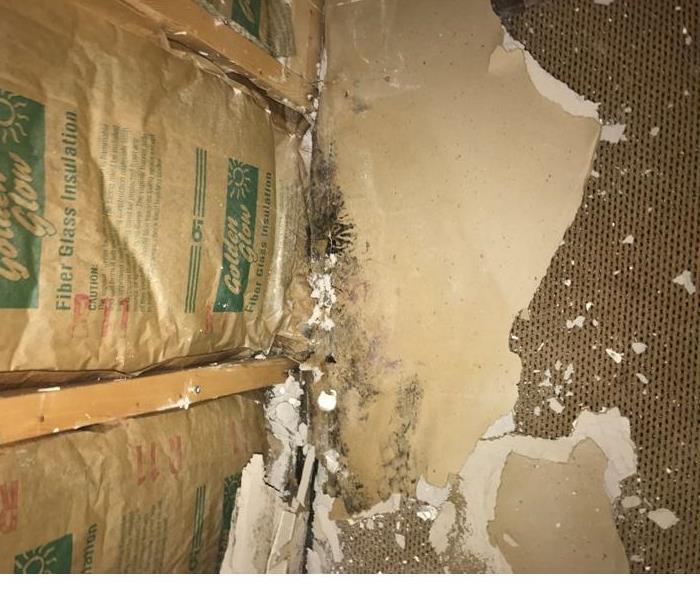 Mold growth that could have been prevented
Mold growth that could have been prevented
The Millers were away for a week and when they came home they noticed a smell coming from the basement. A pipe had developed a leak and was dripping water onto the carpet in their finished basement. The Millers called SERVPRO of Cambridge/Belmont to assist them with the water damage. The crew arrived and checked the basement walls and floor for excessive moisture content. The SERVPRO crew determined that the water had wicked up the walls causing the positive readings. SERVPRO of Cambridge’s technician recommended to cut the walls and remove the insulation behind the walls so that the basement could be dried properly. The customer did not follow thew technicians advice and wanted only to have the pad removed and the carpet dried. A few weeks later, the Millers discovered black spots growing on the walls. They called SERVPRO of Cambridge/Belmont again to assess the situation. SERVPRO determined that mold had started growing and recommended that the walls be cur 6”inches past the mold growth, remove the insulation, heap-vacuum and spray an anti-microbial behind those walls. If you have water damage call SERVPRO of Cambridge/Belmont (617) 864-7378 to assist you and please follow the recommendations of the crew
Case Study - Mold growth caused by a hidden leaky pipe
6/13/2017 (Permalink)
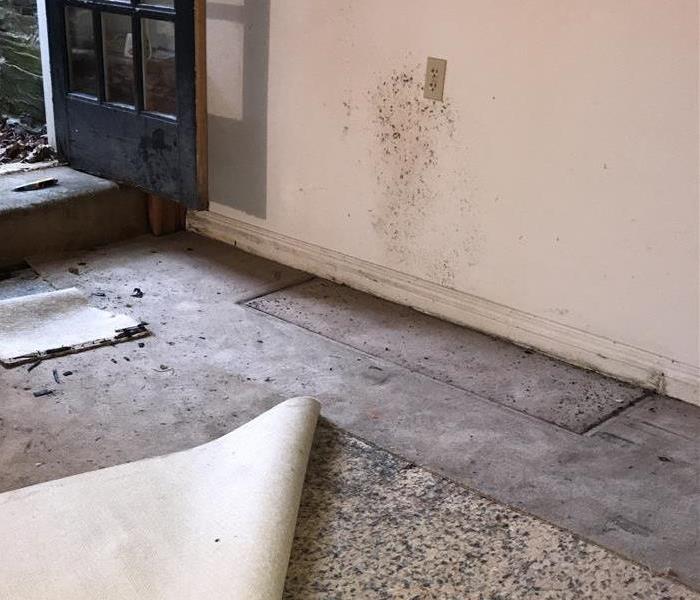 Mold growth on Living Room Wall
Mold growth on Living Room Wall
A homeowner in Cambridge, MA moved a cabinet in their living room and saw black spots behind the cabinet and also growing on the cabinet. The homeowner called SERVPRO of Cambridge/Belmont to assess the situation. The SERVPRO technicians using a moisture meter discovered the wall and ceiling were both wet. The technicians went upstairs to the room above the living room to determine the source of the water. The room above was a bathroom, the technicians using the moisture meter, discovered the bathroom vanity was wet. SERVPRO of Cambridge/Belmont’s technicians removed the wall and found an old leaky pipe that had probably been dripping for a long period of time causing the mold growth in the living room.
Mildew and molds are fungi - simple microscopic organisms that thrive anywhere there is a moist environment. Molds are a necessary part of the environment; without them, leaves would not decay and aspects of soil enrichment could not take place. It is their ability to destroy organic materials, however, that makes mold a problem for people - in our homes and in our bodies.
If you think you have a mold issue, call SERVPRO of Cambridge/Belmont (617) 864-74378 to assist you
Case Study- Mold Growth due to improper water damage remediation
6/8/2017 (Permalink)
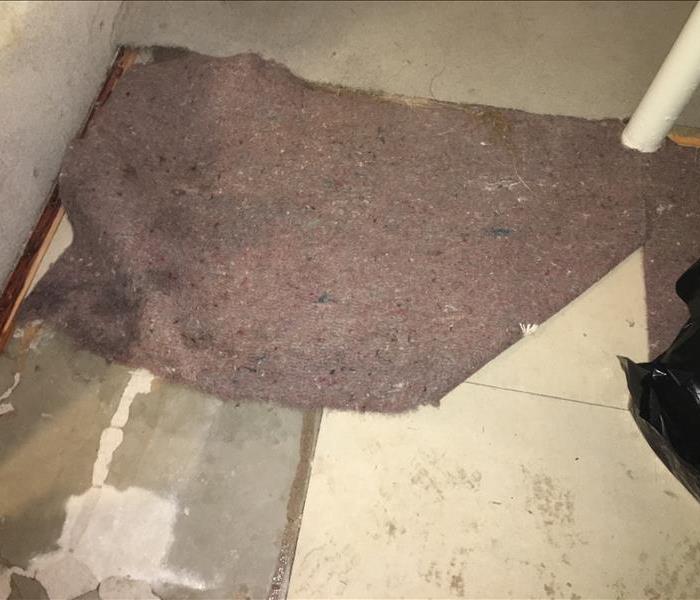 Wet Pad that contributed to mold growth
Wet Pad that contributed to mold growth
A homeowner in Cambridge, MA had her hot water heater burst. The water ran for several hours before she realized that it burst. The water soaked her finished basement. She called her plumber to replace the hot water heater. The plumber recommended that she hire a remediation company to extract the water & dry out the basement. He gave her the name of a carpet cleaning company to help her, not a restoration professional like SERVPRO of Cambridge/Belmont.
The carpet company extracted the water and left some drying equipment and left. A few days later they picked up the equipment and left their bill. A few weeks later she noticed a strong musty odor and black spots growing on the bottom of the walls in the basement. This time a friend recommended that she call SERVPRO of Cambridge/Belmont at (617) 864-7378.
A crew was dispatched to the house, assessed the basement using moisture detectors and an infrared camera and informed the homeowner that the black spots are most likely mold and the walls were still wet from the water damage. He also told her that the smell was coming from the wet pad under the carpet. Melvin Torres, the crew chief on site educated the homeowner on the proper way to remediate a water damage. He explained the proper steps that should have taken place are:
- Assess the entire basement to find the extent of the water intrusion.
- Using a moisture detector or infrared camera , if necessary, determine if the water had wicked up the walls.
- If the walls were wet, determine the least destructive way of drying the walls (remove baseboard & drill holes or if there is insulation behind the walls cut walls 1’ or 2’ up & remove the insulation up to the area cut)
- Move and block furniture and contents
- Remove the pad under the carpet (the pad is non salvageable after a water damage.)
- Spray an antimicrobial under the pad
- Determine if the carpet is salvageable. If salvageable, lift carpet and place air movers (fans) under the corners of the carpet
- Position 1 or 2 dehumidifiers in the area depending on the size of room and area affected
- Monitor the progress of the drying using moisture detectors and a hygrometer
Avoid having a mold issue, if you have a water damage; call the professionals at SERVPRO of Cambridge/Belmont (617) 864-7378.
Mold Remediation
4/18/2017 (Permalink)
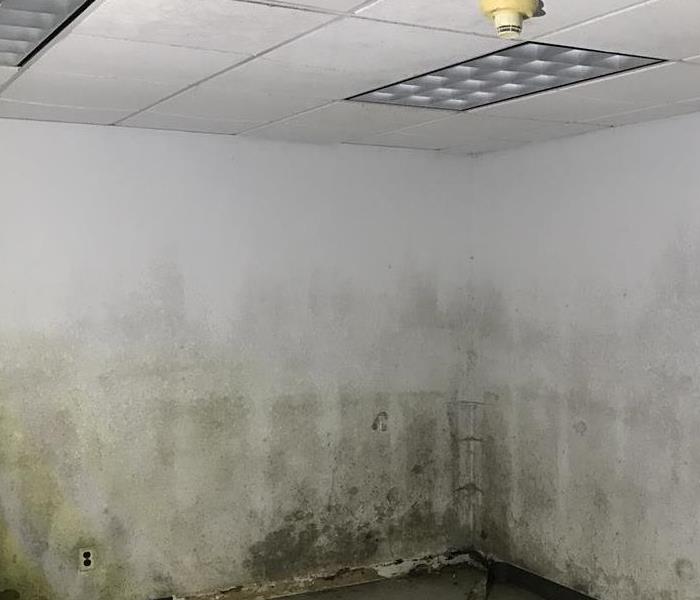 In Belmont, mold can spread through a home in as little as 48 hours.
In Belmont, mold can spread through a home in as little as 48 hours.
Does Your Town of Belmont Home Have A Mold Problem?
In Belmont, mold can spread through a home in as little as 48 hours.
Microscopic mold spores naturally occur almost everywhere, both outdoors and indoors. This makes it impossible to remove all mold from a home or business. Therefore, mold remediation reduces the mold spore count back to its natural or baseline level. Some restoration businesses advertise “mold removal” and even guarantee to remove all mold, which is a fallacy. Consider the following mold facts:
- Mold is present almost everywhere, indoors and outdoors.
- Mold spores are microscopic and float along in the air and may enter your home through windows, doors, or AC/heating systems or even hitch a ride indoors on your clothing or a pet.
- Mold spores thrive on moisture. Mold spores can quickly grow into colonies when exposed to water. These colonies may produce allergens and irritants.
- Before mold remediation can begin, any sources of water or moisture must be addressed. Otherwise, the mold may return.
- Mold often produces a strong, musty odor and can lead you to possible mold problem areas.
- Even higher-than-normal indoor humidity can support mold growth. Keep indoor humidity below 45 percent.
If your home or business has a mold problem, we can inspect and assess your property and use our specialized training, equipment, and expertise to remediate your mold infestation.
If You See Signs of Mold, Call Us Today – (617)489-7378






 24/7 Emergency Service
24/7 Emergency Service











